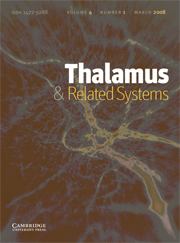No CrossRef data available.
Article contents
Thalamic short-term plasticity and its impact on the neocortex
Published online by Cambridge University Press: 12 April 2006
Abstract
Intracellular recordings from thalamocortical (TC) neurons in the ventrolateral (VL) nucleus as well as paired intracellular recordings from TC-VL neurons and area 4 cortical neurons under ketamine-xylazine anesthesia were performed to study changes in hyperpolarization-rebound sequences evoked by successive stimuli to the dorsal thalamus at different frequencies and the impact of these changes at the cortical level. The cellular mechanisms of such changes in synaptic networks connecting TC with cortical neurons are relevant for short-term plasticity during low-frequency oscillatory activities. The progressive decrease in hyperpolarization of TC cells in response to single thalamic stimulus above a certain frequency (generally >1 Hz) and to pulse-trains at 10 Hz was mainly due to synaptic factors and not to mechanisms intrinsic to TC cells, as revealed by comparing responses evoked by synaptic volleys to those elicited by hyperpolarizing current pulses mimicking the synaptically evoked hyperpolarization-rebound sequence. The decreased hyperpolarization to repetitive synaptic volleys, leading to a decreased number of action potentials in the post-inhibitory spike-burst, had an impact on cortical activities, being matched by a decreased rebound depolarization of cortical cell during repetitive augmenting responses. The alterations in hyperpolarization-rebound sequences upon repetitive stimulation, probably resulting from the decreased efficacy of connections between thalamic reticular (RE) neurons to TC connections, results in the dampening of activities sustaining normal, and possibly paroxysmal, oscillations in the TC network. Our results suggest that this phenomenon should be taken into account when analyzing complex activities, such as physiological and pathological oscillations.
Keywords
- Type
- Research Article
- Information
- Copyright
- 2002 Elsevier Science Ltd


